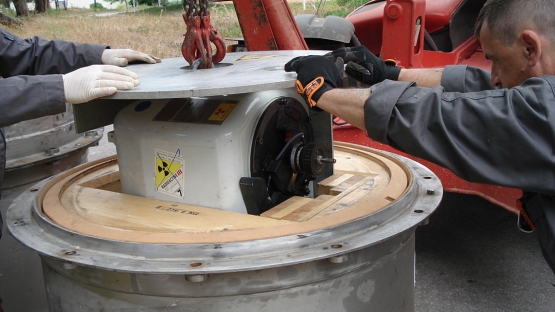Abderrahim Bouih used to be worried about space. In charge of managing Morocco's radioactive waste since 2006, he had long projected that the country's sole radioactive waste facility would fill up by 2019. Thanks to a new methodology he and his colleagues learned through an IAEA project, they can now dismantle smoke detectors, lightning rods and other waste that contains radioactive material, safely separating the radioactive components from the metal, and significantly reducing the amount of radioactive waste they need to store.
"We have condensed 60 drums of waste into just two," said Bouih, Head of the Radioactive Waste Collection, Treatment and Storage Unit at the Moroccan National Centre for Nuclear Energy, Sciences and Technology. "This means our site won't fill up for another 16 years."
From cradle to grave
Radioactive sources are widely used throughout the world in a broad range of sectors including industry, construction, medicine, agriculture and research. Taking a holistic approach to managing radioactive sources from 'cradle to grave' enhances safety and security, and enables countries to overcome limitations to obtain radioactive sources from suppliers.
"It is vital that radioactive sources are properly labelled and registered at their origin, and that appropriate control mechanisms are in place to trace them throughout their life cycle, from the manufacturer to the user and ultimately to their safe disposal," said Juan Carlos Lentijo, the IAEA's Director of Nuclear Fuel Cycle and Waste Technology. The most critical point in the life cycle of radioactive sources is "when they are not any more of value, but they become a burden for the user," he said.
Morocco has thousands of items containing low level radioactive waste. Bouih and his colleagues regularly get calls from local authorities and companies from across the country to pick up their waste. "Next week we are going to an old hotel to collect 200 smoke detectors," he said. Older generation smoke detectors and lightning rods often have a small radioactive source as an active component of the device.
Back to France for processing
As another outcome of its work with the IAEA, Morocco for the first time ever sent three old radiotherapy machines used for medical imaging back to France for processing last year. "Being able to provide a safe solution for our radioactive waste was a major step for us," Bouih said. The radioactive components used in radiotherapy machines are generally more hazardous to human health and the environment, and may also be more vulnerable to theft or misuse if they are not managed securely, than the majority of the more benign sources used in industrial applications and research. Morocco, like most other countries without a nuclear industry, is not appropriately equipped to manage waste with high levels of radioactivity. The IAEA arranged, oversaw and supervised the repatriation process.
Being able to provide a safe solution for our radioactive waste was a major step for us.





